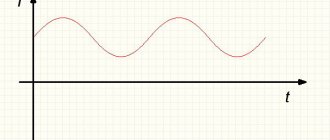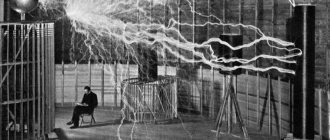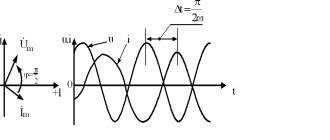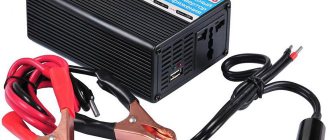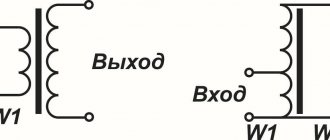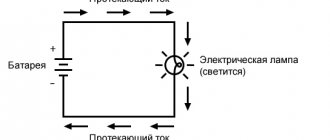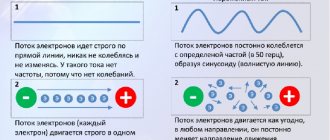High frequency current
Details Category:
HIGH FREQUENCY CURRENT
, high frequency alternating electric current; in the presence of an appropriate emitter - antenna, it emits energy into space over significant distances in the form of electromagnetic waves, which, in turn, cause currents of the same frequency in receiving devices located far from sources of high-frequency current.
High-frequency current is used in radiotelegraphy and radiotelephony, when transmitting images over a distance, telemechanics, and in general in all those cases where it is necessary to transmit electromagnetic energy over a distance without the help of wires. The frequency range of currents in these areas of technology currently ranges from 15,000 AC/sec. (wavelength 20000 m) up to 300000000 per/sec. (wavelength 1 m).
When moving through wires, high-frequency current has the following features that distinguish it from low-frequency alternating electric currents: 1) High-frequency current in wires is distributed in the layers closest to the surface; 2) the least resistance for high-frequency current is represented, therefore, by wires not with the largest cross-sectional area, but with the largest cross-sectional perimeter; 3) the resistance of the wires increases with the frequency of the currents; 4) self-inductance of wires with high-frequency current is lower than with low-frequency alternating currents;
5) the inductive reactance of wires with high-frequency current is much higher than in the case of low frequencies: it increases with frequency; 6) the physiological effect of high-frequency current differs significantly from the same low-frequency current; in particular, high-frequency currents are not life-threatening. Due to what was said in paragraph 1, wires for high-frequency currents are made either in the form of hollow tubes, or in the form of tapes, or are made up of subdivided thin conductors. High-frequency currents are produced in the following ways: 1) through repeated discharges of capacitors through the spark gap in spark transmitters; 2) through a voltaic arc in arc transmitters; 3) through high frequency machines; 4) through electronic generator tubes. High-frequency currents resulting from capacitor discharges are characterized by damped oscillations; high-frequency currents produced by arc transmitters, high-frequency machines and vacuum tubes are characterized by undamped oscillations.
Source: Martens. Technical encyclopedia. Volume 4 - 1928
- < Back
- Forward >
High currents at low temperatures
Science and life // Illustrations
‹
›
Superconductors are divided into two broad classes - low-temperature, operating at temperatures close to the temperature of liquid helium (4.2 K), and high-temperature, passing high-density currents without loss (up to 106 A/cm2 of the cross-section of the conductor) at the temperature of liquid nitrogen. Low-temperature composite superconductors are a composite wire (strand) with a diameter of 0.5–2.0 mm, a length of up to 50 km, containing in a metal matrix several tens of thousands of continuous superconducting fibers with a diameter of 1.5–5 μm each.
The first high-temperature superconductors were made in the form of hard and complex ceramic fibers distributed in a silver matrix containing the compound Bi2Sr2Ca2Cu3Ox (Bi-2223). They have found application in electrical devices for a variety of purposes, from medical diagnostics to particle physics research. However, the first high-temperature ceramic superconductors, along with unique electrical characteristics, had a number of properties that made their use difficult. Due to the complexity of the crystal structure and the large number of components in the composition, they were extremely fragile, had low chemical stability, a tendency to phase transformations and oxygen migration, and a sharp anisotropy of physical properties, including the critical current density.
Specialists of the High-Technology Research Institute of Inorganic Materials (VNIINM) named after. A. A. Bochvara, together with other institutes, is developing low-temperature superconductors based on a deformable superconducting Nb-Ti alloy and a superconducting intermetallic compound Nb3Sn. Nb-Ti or Nb3Sn fibers are arranged in a specific manner in a matrix of copper or a copper-based alloy. In addition, the strand design includes a stabilizing copper sheath and a diffusion barrier, usually made of niobium or tantalum. (The photo shows cross sections of several designs of composite rods.)
VNIINM developed designs and manufacturing technologies for composite superconductors from Nb-Ti and Nb3Sn for the magnetic system of the international thermonuclear experimental reactor ITER under construction, and at the Chepetsk Mechanical Plant the first domestic industrial production of low-temperature superconductors was launched and about 220 tons of such single superconductors were manufactured. The production capacity makes it possible to establish industrial production of Nb-Ti superconductors for other megaprojects, as well as Nb-Ti strands for medical tomographs.
The institute has been working on high-temperature composite superconductors since their discovery in the mid-1980s. Now work is underway here on second-generation high-temperature superconductors. They are flexible metal strips up to several hundred meters long and 4–12 mm wide with a thin layer of superconducting ceramic Y(Gd, Dy)-Ba2-Cu3-OX deposited on them, where x = 6.5–6.94. High critical current densities (up to 5 MA/cm2 at 77 K) can be achieved only if the coating has a pronounced texture. The thickness of the HTSC layer is small, on the order of 1 micron, which, however, is sufficient to achieve critical conductor current values of several hundred amperes.
Recently, superconductors based on magnesium diboride (MgB2), discovered at the beginning of this century, have attracted interest due to their low cost and high electrical characteristics. VNIINM's developments were shown at an exhibition dedicated to the Open Innovations forum.
The irony of DC
To appreciate the irony of the situation with the return of direct current to high-voltage power lines, you need to remember the events of the “War of Currents” - a battle between apologists for direct current represented by the inventor and businessman Thomas Edison and alternating current, the advantages of which were realized by entrepreneur George Westinghouse. Let's take a quick look at how DC lost the battle to become the backbone of the world's energy supply.
After humanity subjugated electricity and learned to benefit from it in industry, far-sighted businessmen realized that by electrifying cities in the future they could make not just capital, but a fantastic fortune. Inventor Thomas Edison was excellent at monetizing his talent as an innovator and made money not so much from his own inventions as from improving the ideas of others. One example of such a successful “fine-tuning” was the creation of an incandescent lamp, which appeared thanks to arc lamps with carbon electrodes that fell into the hands of Edison. Although such lamps provided light, they were not suitable as constant sources of lighting - in those days, carbon arc lamps worked for several hours at most, and they could only be turned on once.
Edison's first production lamp - still with a carbon filament and an operating time of several tens of hours. Source: Terren / Wikimedia Commons
Having improved the design and created his famous incandescent lamp, which could work for 40 hours, and after modification for 1200 hours, Edison realized that his light bulb could become the basis of lighting systems for cities and buildings - giving brighter light compared to candles and gas lamps, incandescent lamps had a lower cost, did not smoke, did not burn oxygen in the premises, and required replacement less frequently than the same candles. The production of lamps was undertaken by the Edison Electric Light enterprise, and the production of direct current generators by Edison General Electric. By selling lamps below cost, Edison conquered the lighting market, and began building power grids in London and New York for the first consumers.
An incandescent lamp can operate with both alternating and direct current, but Edison chose direct current. The reason for this decision is very trivial and far from physics. As we said, Edison was not only an inventor, but also a very enterprising businessman. He saw electricity not only as a way to cheaply illuminate cities, but also as an opportunity to modernize industry through the introduction of electric traction. The electric motors that existed at that time operated only on direct current.
In addition, in order to make money on electricity supplies, it was necessary to somehow measure the consumption of each subscriber. Edison created an individual meter, which was a reservoir with an electrolyte and a plate on which copper was deposited under the influence of a passing current - every month the plate was weighed and electricity consumption was calculated based on the difference in mass. Such a meter worked only with direct current.
DC meter designed by Thomas Edison. “Transfer of readings” consisted of handing over a jar of plates to representatives of the power company. Source: Thomas A. Edison Papers / edison.rutgers.edu
But direct current also had unsolved problems, the main one of which was the impossibility of transmitting high power over long (more than 2 km) distances. In order to transmit the high power that is necessary to power an enterprise or a city lighting system, either the current or the voltage must be increased in the electrical network (power, recall, is equal to the product of voltage and current). But at the end of the 19th century there were no ways to change DC voltage. Electrical appliances produced in the USA operated on a voltage of 110 V, so Edison's power plants, which operated on steam generators, had to send exactly 110 V to the network.
All that remained was to control the current strength. As the current increases, part of the energy is spent on heating the wires (there is no such problem with high voltage). To reduce losses and heating, you need to reduce the resistance by increasing the diameter of the conductor or using materials with good electrical conductivity, such as copper. And still, losses will increase depending on the length of the cable.
To reduce the length of the conductor to acceptable levels, consumers had to be located no further than 1.5-2 km from the power plant, otherwise the power in the network would drop to unacceptable values. For example, on the 56-kilometer line between the French cities of Creil and Paris, losses reached 45%. No matter how Edison struggled with the problem of losses in DC networks, he was never able to solve it. The only solution was to build low-power power plants near consumers. At that time it did not seem like an outrage against the environment and residents - these were precisely the stations that Edison’s company built. The first of these was built on Pearl Street in Manhattan, New York in 1882, the same year the installation of underground 110-volt DC cables began.
Edison laid underground power lines for street lighting even before it became fashionable in Moscow. The illustration shows the installation of a DC line in New York in 1882. Source: WP Snyder/Wikimedia Commons
Thomas Edison realized the error of his choice, although he did not publicly admit it, when his competitor in the electrical business, George Westinghouse, began investing in the construction of power plants and alternating current networks, which had serious advantages over direct current networks. Thanks to transformers that had already been invented by that time, alternating current voltage could be easily increased and decreased. Transformers solved the problem of transmitting high power, because instead of current, you could simply increase the voltage, the transmission of which did not require thick wires made of expensive copper.
In this way, Westinghouse networks could transmit very high power over cheap, smaller-diameter cables with virtually no losses. This is proven by the example of a 175-kilometer alternating current network between the German city of Lauffen am Neckar and Frankfurt - its efficiency was 80.9% after launch in 1891 and 96% after modernization - incomparably higher than 45% at a three times shorter distance for the direct current network .
Three-phase alternator in Lauffen am Neckar, Germany. Source: Historisches Museum, Frankfurt
AC networks had no hard limit on length. Thanks to this, it became possible to build hydroelectric power stations, from which electricity could be transmitted to large cities located tens and even hundreds of kilometers from the place of generation. And a hydroelectric power station is a much more significant and profitable project than a low-power coal station inside the city.
The “War of Currents” continued with Edison’s ugly PR campaign against alternating current (shown, in particular, in the 2022 feature film “The Current War”, directed by A. Gomez-Rejon), judicial and legislative red tape against Westinghouse and the gradual loss Edison's business position under pressure from the increasingly popular AC networks. The last Edisonian DC power plant ceased operation in 1981, but as for consumers, there are still hundreds of facilities in San Francisco (mostly vintage elevators) using DC through AC rectifiers. But for us this is no longer so important.
